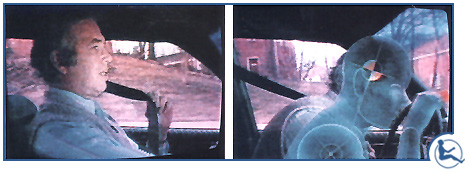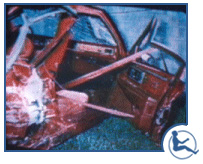|
|
 |
Seatbelts - Slack
"Automatic" seatbelt designs that were used in some vehicles placed the shoulder belt across your torso as you sat down and closed the door. But for optimal safety, you still had to remember to always manually buckle the lap belt, and a North Carolina study showed only 28-percent remembered to do so. In some crashes, the occupant would "submarine" below the shoulder belt, and receive severe to fatal injuries to their neck or abdomen or liver. The lack of an "anti-submaring" seatpan also allowed the belted occupant to slide forward, with the lap belt riding dangerously up and across the abdomen.

Rear seat lap-belt-only designs, with no shoulder belt , can be injurious or lethal, especially for children. Rear seat occupants should have the superior protection of the combination of lap and shoulder seatbelts, rather than just a lap belt. There have been severe abdominal and spinal injuries, especially to children, that are caused when they "jacknife" forward over the lap belt in a frontal crash.
Excessive "spool-out" of the belt from its retractor, often as much as 5 inches or more, allows the belted occupant to slam their head into the steering wheel or dash or windshield, or out the side window. Seatbelt retractors typically require the inertial movement of a small pendulum device in response to the deceleration in a crash, to lock the belt and prevent it from coming any further out, but the belt will stay locked only if stress is maintained against the belt webbing.... which is often not the case in rollovers and multiple collision accidents.
Seatbelt pre-tensioners automatically snug the lap belt and shoulder belt at the start of a crash, enabling the occupant to better "ride down" the deceleration forces of the crash, and for snugger restraint in side impacts and rollovers. Known about for years, pre-tensioners are being phased into many new cars, minivans, and pickups, though not typically for all front and rear occupants. An occupant in an SUV rollover or side impact who is severely injured because their seatbelt lacked a pre-tensioner, may likely have a meritorious case.
 A novel "windowshade" type of seatbelt was used in millions of cars, pickups, and vans that were built by GM, Ford, and Chrysler from the mid-70's through about 1990. The windowshade feature allowed you to pull the shoulder belt out of its retractorfor more loose-fitting comfort... but it often became progressively looser while you' were driving, and it would stay loose, much too loose to protect you in a crash. A novel "windowshade" type of seatbelt was used in millions of cars, pickups, and vans that were built by GM, Ford, and Chrysler from the mid-70's through about 1990. The windowshade feature allowed you to pull the shoulder belt out of its retractorfor more loose-fitting comfort... but it often became progressively looser while you' were driving, and it would stay loose, much too loose to protect you in a crash.
Another bad design, favored by GM over the years, attaches both the lap and shoulder belts to the door. If the door comes open in a crash, the belt no longer restrains the occupant, who can be ejected. It also fits poorly across the chest, and may cut dangerously across the wearer's neck. Car dealers invariably disconnected these door-mounted automatic in their showrooms (a violation of federal law). In daily use, most drivers and passengers disconnect and reconnect them as they exit and enter their car ... thus defeating their so-called "automatic" intent.
Safer seatbelts should always fit properly and snugly, and stay snug throughout the crash or rollover. It is important to have adjustable up-and-down anchorages for the shoulder belt help ensure a good fit for taller and shorter occupants. Some recent designs also incorporate the lap and shoulder belt directly into the seat itself, which also requires a stronger seat structure and stronger seat anchorages.
|